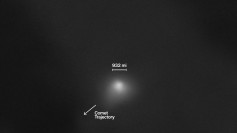On Friday (Mar. 4), a rogue rocket stage is set to strike the moon, drawing scientific attention to the event.
The rocket stage is on track to slam into Hertzsprung Crater on the far side of the moon on Friday at 7:25 a.m. EST (1225 GMT). According to scientists, this will be the first time a piece of space trash has collided with the lunar surface by mistake, excluding spacecraft that have crashed while attempting to land on the moon or rocket bodies that have been deliberately guided into Earth's nearest neighbor.
The Goldstone Solar System Radar near Barstow, California, is set to observe the object a few days before impact, according to reports. And NASA's Lunar Reconnaissance Orbiter (LRO) will examine the lunar surface for the impact crater after looking for changes in the moon's exosphere - a thin layer of gases - as a result of the collision.
The impact on Mar. 4 will be comparable to that seen during NASA's Apollo mission, when the third stages of massive Saturn V rockets were deliberately directed into the moon. Jeffrey Plescia, a planetary scientist at Johns Hopkins University's Applied Physics Laboratory in Maryland, noted that the moon-smacking projectile is more or less a tin can in both circumstances.
"The result is that a lot of the energy goes into crushing the projectile rather than excavating the crater," Plescia told Inside Outer Space, via Space.com.
The Saturn V third stages formed craters that are shallower than natural craters and have an uneven shape, which Plescia attributes to the low impact angle.
"Always good to know the parameters of the projectile for better understanding the cratering process," he said.
Initially, the rocket body was assumed to be the upper stage of the SpaceX Falcon 9 rocket that launched the U.S. NOAA's Deep Space Climate Observatory (DSCOVR) in 2015.
The object, however, is now linked to the Chinese Long March 3C rocket, which launched China's Chang'e 5-T1 mission in 2014. Chang'e 5-T1 returned to Earth after looping beyond the moon to test atmospheric re-entry capabilities for the Chang'e 5 lunar sample return mission in 2020. On behalf of the Luxembourg-based business LuxSpace, Chang'e 5-T1 also carried a secondary payload of scientific instruments in the upper stage of the Long March rocket.
Bill Gray, the manager of Project Pluto, which provides commercial and free astronomical software to amateur and professional astronomers, is one of several who have made the China connection.





